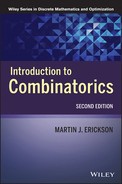PREFACE
This book is an update and revision of my earlier textbook of the same title. The most important change is an increase in the number of worked examples and solved exercises. Also, several new topics have been introduced. But the overall plan of the book is the same as in the first edition: to introduce the reader to the basic elements of combinatorics, along with many examples and exercises.
Combinatorics may be described as the study of how discrete structures can be counted, arranged, and constructed. Accordingly, this book is an introduction to the three main branches of combinatorics: enumeration, existence, and construction. There are two chapters devoted to each of these three areas.
Combinatorics plays a central role in mathematics. One has only to look at the numerous journal titles in combinatorics and discrete mathematics to see that this area is huge! Some of the journal titles are Journal of Combinatorial Theory Series A and Series B; Journal of Graph Theory; Discrete Mathematics; Discrete Applied Mathematics; Annals of Discrete Mathematics; Annals of Combinatorics; Topics in Discrete Mathematics; SIAM Journal on Discrete Mathematics; Graphs and Combinatorics; Combinatorica; Ars Combinatoria; European Journal of Combinatorics A and B; Journal of Algebraic Combinatorics; Journal of Combinatorial Designs; Designs, Codes, and Cryptography; Journal of Combinatorial Mathematics and Combinatorial Computing; Combinatorics, Probability & Computing; Journal of Combinatorics, Information & System Sciences; Algorithms and Combinatorics; Random Structures & Algorithms; Bulletin of the Institute of Combinatorics and Its Applications; Journal of Integer Sequences; Geombinatorics; Online Journal of Analytic Combinatorics; and The Electronic Journal of Combinatorics. These journal titles indicate the connections between discrete mathematics and computing, information theory and codes, and probability. Indeed, it is now desirable for all mathematicians, statisticians, and computer scientists to be acquainted with the basic principles of discrete mathematics.
The format of this book is designed to gradually and systematically introduce the main concepts of combinatorics. In this way, the reader is brought step-by-step from first principles to major accomplishments, always pausing to note mathematical points of interest along the way. I have made it a point to discuss some topics that don’t receive much treatment in other books on combinatorics, such as Alcuin’s sequence, Rook walks, and Leech’s lattice. In order to illustrate the applicability of combinatorial methods, I have paid careful attention to the selection of exercises at the end of each section. The reader should definitely attempt the exercises, as a good deal of the subject is revealed there. The problems range in difficulty from very easy to very challenging. Solutions to selected exercises are provided in the back of the book.
I wish to thank the people who have kindly made suggestions concerning this book: Mansur Boase, Robert Cacioppo, Duane DeTemple, Shalom Eliahou, Robert Dobrow, Suren Fernando, Joe Hemmeter, Daniel Jordan, Elizabeth Oliver, Ken Price, Adrienne Stanley, and Khang Tran.
I also gratefully acknowledge the Wiley staff for their assistance in publishing this book: Liz Belmont, Kellsee Chu, Sari Friedman, Danielle LaCourciere, Jacqueline Palmieri, Susanne Steitz-Filler, and Stephen Quigley.
